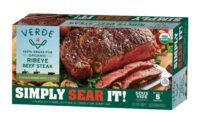Demand for grass-fed beef to remain deferred amid COVID-19 uncertainty

By Santosh Kumar, Senior Research Consultant, Fact.MR
Nutritional composition, which significantly influences consumers, suffices as a fundamental differentiating factor between grain-fed and grass-fed meat. Grass-fed meat has 100% of the nutrients required for humans in the perfect balance and is often associated with health benefits. Whereas, the market's conventional counterpart, grain-fed meat, is presumed nutritionally deficient. Grass-fed meat - being a more salubrious meat alternative - is steadily gaining traction among meat-consuming nations. However, the steady growth trajectory is being obstructed due to the unanticipated outbreak of COVID-19. The travel restrictions imposed by national governments on the back of the pandemic are impeding the import and export activities thus thwarting the projected growth trajectory.
The current decline in revenue mirrors the circumstances during 2008's global economic crisis when beef observed a similar drop of approximately 10%. After the market commenced recovery in 2010, the demand doubled instantly. Likewise, during the European debt crisis, the growth of the meat industry severely flattened. However, the market alleviated after two years. Along similar lines, the market growth is expected to experience turbulence before emerging from the COVID-19 crisis.
Awareness to Play a Crucial Role in Consumption Growth
Although the demand continues to rise year-on-year, being a relatively new eating experience, grass-fed meat is yet to gain significant traction among consumers. The players in the grass-fed market are focusing on educating consumers about the nutritional privileges of grass-fed meat. Spreading awareness is the first step in making consumers accustomed to the market's offerings. The majority of North America's livestock producers lack awareness regarding breeding cattle on grass, as they are acquainted to the utilization of feed grain for cattle. As players focus on the newer nuances of grass-fed meat, grass-fed meat products will grow in volume.
Nutritional Benefits over Conventional Variants to Accelerate Demand
Grass-fed meat holds numerous benefits on the nutritional front as compared to its conventional variants. The grass-fed meat consists of key nutrients, including antioxidants, vitamin E, and conjugated linoleic acid (CLA), a fatty acid, frequently associated with a reduction in heart disease, cancer risks, and improving immunity. Moreover, grass-fed beef, in particular, consists of 50% more omega-3 fatty acids than standard beef. Besides, grass-fed beef holds a lower possibility of containing superbugs - a strain of bacteria capable of resisting three or more classes of antibiotics. In general, the possibility of ‘superbugs’ contamination in conventional beef is thrice as that of grass-fed beef. Feed grass meat is also known for less content with an average of 10 percent fat or less. Owing to this healthy nutritional composition, feed grass meat is deemed superior from the food safety and health perspective.
International Trading Profoundly Strengthens Grass-Fed Meat Market
The demand for lamb is primarily attributed to its lower cost as compared to beef. Grass-fed lamb and goat are foreseen to capture around 1/3 of the global grass-fed meat consumption in regions such as Europe, Southeast Asia, Latin America, and Middle & Africa. Amongst these regions, Oceania is one of the principal exporters, accounting for nearly 70% of the global lamb exports. Oceania exports nearly 30% of grass-fed sheep supplies to Europe, a major importer.
On the same lines, consumption of grass-fed sheep in the Middle East & Africa is highest among all the regions, on the back of high demand for halal meat. On the other hand, the demand for lamb and goat meat is forecasted to witness an upsurge in Southeast Asia backed by increasing trading activities post the ASEAN trade agreement. Moreover, New Zealand accounts for a lucrative share in Oceania's export valuation.
Invigorated by the high demand for grass-fed meat in food processing sectors, the market in North America and Europe will witness high demand growth for grass-fed meat in the near future. However, the market is not free of restraints. High price rates associated with the grass-fed meat continues to circumscribe widespread consumption. Notwithstanding this, the market has found a new combatant in the form of COVID-19, which can repaint the forecasted growth picture, while the scale of impact depends on the extent of the pandemic’s influence on these regions.
Hindered Trading Activities Due to COVID-19 Impeding Market Growth
The unforeseen outbreak of COVID-19 has brought business activities all around the world to a screeching halt. The pandemic is adversely impacting the global food & beverage industry, on the back of national lockdowns, disruptions in supply chains, and changing consumer preferences. The travel restrictions are stirring the smooth trade activities of livestock and meat across international borders. As international trading came to a screeching halt due to national lockdowns, producers of grass-fed meat in North America and Brazil are obligated to sell within their respective nations. The grass-fed meat market, which is only a part of the overall meat industry, is sure to witness a negative impact on its revenue stream, owing to the aforementioned factors.
The pandemic has exhibited its impact as early as January 2020, when the demand for the grass-fed meat faced a sharp decline, as compared to that of the preceding years. According to the United States Department of Agriculture (USDA), the demand for beef and veal from China dropped by nearly 10% in January. Similarly, New Zealand witnessed a downfall of around 40% in meat import from China in February.
Recovery Period to Remain Uncertain
Having beheld the adverse effects of the pandemic in the first quarter of 2020, uncertainty prevails on the recovery time. On an optimistic note, if the market recovers in the second quarter of the year, the demand and sales will witness an upsurge on the back of consumer demand. However, a slightly dubious situation will prevail if the pandemic prolongs through the second quarter. Under that circumstance, the market will find relief only in the third quarter. In case the situation worsens and extends beyond the third quarter, the impact will collectively shake-up annual revenue, and the recovery of the market will defer to 2021.
Santosh Kumas is a Senior Research Analyst at Fact.MR, with a proven experience in market research and consulting industry and has been closely working on Food and Beverages vertical of Fact.MR. Santosh is currently the lead consultant for product positioning, competitive analysis, new market segment exploration, and sourcing strategies at Fact.MR. These insights are based on a report on Grassfed Meat Market by Fact.MR.
Looking for a reprint of this article?
From high-res PDFs to custom plaques, order your copy today!







